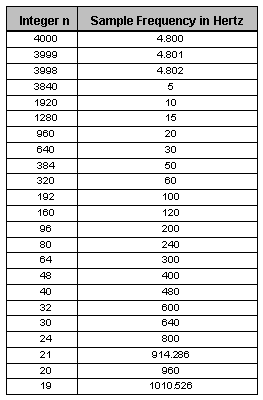


 |
 |
 |
Table of ContentsConnecting to the 24/7 Data Acquisition Module Converter Noise and Effective Resolution Other Sources of Noise and Offset Error Tips For Measuring Small Voltages Addressing the 24/7 WildCard Using Module Select Jumpers Initializing the 24/7 Data Acquisition Wildcard Specifying the Reference Voltage Calibration Options Single- and Multi-Channel Sampling Continuous Sampling from a Single Channel |
24/7 Data Acquisition Wildcard Users GuideThe sample period is equal to the multiplicative inverse of the sample frequency. 
Table 5: Some representative sample frequencies. Changing the sampling frequency as well as the gain impacts resolution. Table 6, taken from the manufacturers datasheet, shows the effect of the sampling frequency and gain on the effective resolution. 
* Values in parentheses indicate our own measurements of the effective resolution. In Table 6, the sample frequencies are rounded to the nearest whole number and values in parentheses indicate our own measurements of the effective resolution. The analog to digital converter internally adds approximately 1 μV of noise on its analog inputs. This limits the accuracy of the converter at different sample frequencies. The table shows that the other components on the module (including the analog switches and protection circuitry) add an additional 1 μV of noise to the analog to digital converter. The 24/7 Data Acquisition Wildcard has a built in low pass filter that has a first notch filter frequency equal to the sample frequency and a -3dB frequency equal to about one quarter of the sample frequency (0.262 x sample frequency). At the sample frequency and integer multiples of the sample frequency, the filter attenuates input signals by more than 100 dB. For example, if 10 Hz is used as the sample frequency, there will be notches at 50 Hz and 60 Hz that will significantly attenuate all differential and common-mode noise. |
Home|Site Map|Products|Manuals|Resources|Order|About Us
Copyright (c) 2006 Mosaic Industries, Inc.
Your source for single board computers, embedded controllers, and operator interfaces for instruments and automation